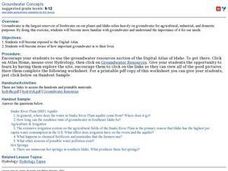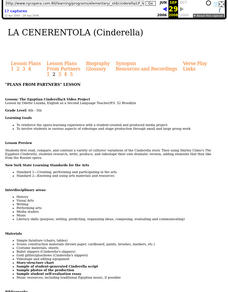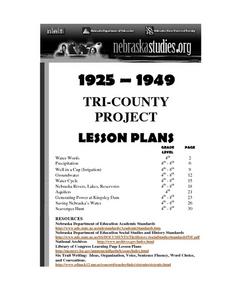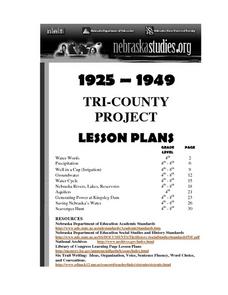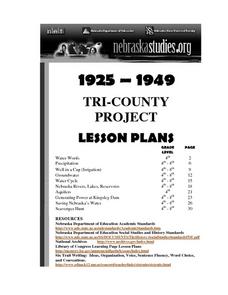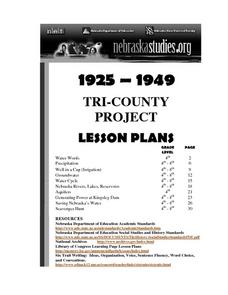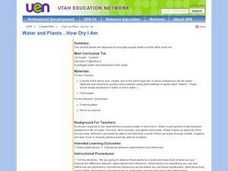Curated OER
Conserving Resources by Watering Efficiently
Learners determine a watering schedule that promotes healthy grass growth. In this plants and natural resource conservation lesson plan, students plant grass seed in liter bottles and follow two different schedules that include "more...
Curated OER
The King of Ranches
In this The King of Ranches worksheet, students watch the video The King of Ranches and fill in the blanks to sentences about it. Students complete 11 sentences.
Curated OER
Groundwater Concepts
High schoolers use a digital atlas and other electronic resources to explore freshwater reservoirs in Idaho. They discover the importance of groundwater and discuss the agricultural, industrial and domestic uses of underground...
Curated OER
Wildlife Sampling
Seventh graders use paper bags and crackers to simulate a wildlife sampling of salmon. They record data on spreadsheets and determine a formula to estimate salmon populations.
Curated OER
La Cenerentola (Cinderella)
Students reinforce the opera-learning experience with a student-created and produced media project. Also, students get involved in various aspects of videotape and stage production through small and large group work
Curated OER
Do Human Practices Affect Water Quality?
Students determine if human practices have any noticeable effects on the quality of stream life as measured by the presence of certain macroinvertebrates. They collect, preserve and identify macroinvertibrate samples and quantify the data.
Curated OER
How Dry I Am
Students observe two similar plants as one gets regular water and one does not. They observe plants for a week and record their findings.
Curated OER
How Much Azatrine?
Learners understand the connections among people, places, and environments in the local school and community, Kansas and its surrounding states, the U.S. and its region, and the world.
Curated OER
Clean Kansas Water
Students gain an understanding of ways we can be responsible custodians of our water supply. Students explore the governor's clean water initiative involving the Lower Kansas/Republican river basin and the pollutants present there.
Curated OER
Using Our Natural Resources Wisely
Students understand how ground water can be recycled to maximize its usage and begin to think about ways conservation can help Kansas preserve its natural resources in other areas - soil, minerals, and clean air.
Curated OER
Drop in the Bucket
Young scholars study the sources for the water they use. They determine their town's major water supply and how many gallons per day does the population use.
Curated OER
"Tri-County" Project--Ground Water
Learners explore data on some of the landforms in Nebraska to distinguish between porous and nonpremeable soils. The state's groundwater is investigated.
Curated OER
"Tri-County" Project--Ogallala Aquifer
Students explore the Ogallala Aquifer in the state of Nebraska. The signs of pollution found are examined and the data classified.
Curated OER
"Tri-County" Project--Rivers Lakes Reservoirs
Students examine data about the rivers, lakes, and reservoirs in the state of Nebraska. An understanding of the political implications of boundaries is developed.
Curated OER
Tri-County Project: Precipitation
Learners examine and research the annual rainfall in Nebraska. They create a map of the annual rainfall in Nebraska and use the map to develop explanations of settlement.
Curated OER
"Tri-County" Project--Water Cycle
Students analyze the parts of the water cycle through research and experimentation. Particular attention is paid to the processes of evaporation and condensation.
Curated OER
"Tri-County" Project--Well in a Cup
Pupils construct a model of a well to identify how water is brought to the surface. Signs of pollution are investigated.
Curated OER
Water and Plants...How Dry I Am
First graders observe two similar plants as one gets water and the other does not. They make predictions and chart the growth of each. They draw pictures of the plants after one week.
Curated OER
Global Water
Students collect data on their household water use and calculate how many gallons of water a person uses per day. They investigate how students in different parts of the world get their drinking water.
Curated OER
Flood Control Project
Students examine the reasons why dams were built in Nebraska. They identify factors that need to be considered when building a dam. They create a dam of their own.
Curated OER
Nature's Air Conditioner
Students observe the process of transpiration in leaves. They measure how much water a leaf gives off in a 24-hour period, calculate the volume, and answer discussion questions.
Curated OER
Problems Facing Agriculture
Fourth graders examine the conflicts over land ownership and water in the second half of the 1800s in California. They write a criticism about the problems that farmers faced, and work in pairs to define key vocabulary terms.
Curated OER
China
Students explore the geography, culture and history of China. As a class, they discuss historical contributions to China, Confucius, and geographic features of the country. Pupils use the internet to answer questions about China.
Curated OER
NCTA Lesson Plan on China
Students identify China's geography, especially arable land, rainfall, crop growing areas, rivers, and mountains. Students select a technological advance to draw a diagram of the particular advance make transparencies of the diagram,...
Other popular searches
- Irrigation Mesopotamia
- Ancient Egyptian Irrigation
- Irrigation Sumer
- Basin Irrigation
- Early Irrigation
- Irrigation Systems
- Irrigation and Fertilizer
- Irrigation in Egypt
- Ancient Irrigation
- Drip Irrigation
- Irrigation Egypt
- Egypt and Irrigation




